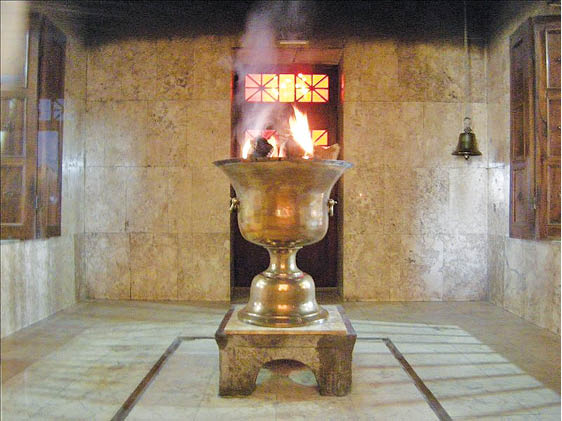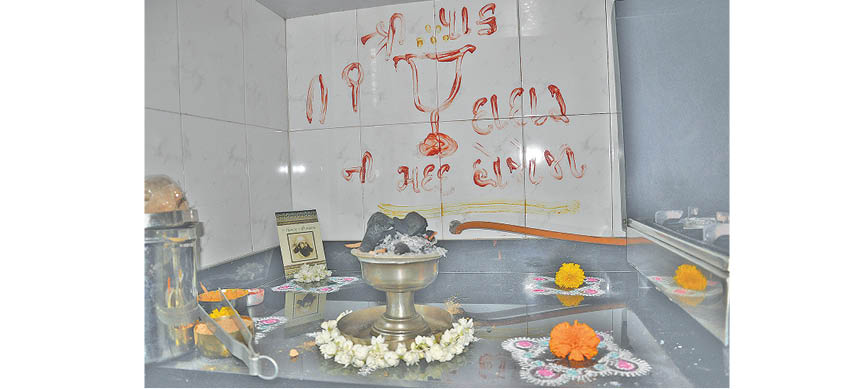Adar is the Divinity that presides over fire. In the Zoroastrian calendar, Adar is the ninth day of every month of thirty days and also the ninth month of the year of twelve months. Nine is a sacred number across several religious traditions. In the Zoroastrian tradition, Prophet Zarathustra is often depicted holding a nine-knotted stick called Navgar. Among Hindus, nine is the number of Brahma, the Creator. Among Christians, number nine symbolizes divine completeness and conveys the meaning of finality. Christ died on the cross at the ninth hour of the day (03:00 pm) to pave the path of salvation for everyone. Also, Jesus appears nine times to his disciples and apostles after his resurrection. Mathematically, when multiplied nine always reproduces itself.
Interestingly, Adar (Akkadian Adaru) is also the twelfth month of the ecclesiastical year on the Hebrew calendar. The Hebrew name Adar (pronounced ‘Ay daar’) is related to the word Adir which denotes strength and power.
Atash Nu Parab:
Parsis celebrate Ruz (day) Adar of Mah (month) Adar as ‘Atash nu parab’. When Ruz and Mah coincide, the day is celebrated as parab. The feast actually begins the day before (Ruz Dae-pa-Adar) when the women of the household celebrate the Chulah nu varas, which literally means birthday of the hearth Fire over which food is prepared throughout the year. The kitchen is cleaned and the area around the cooking stove is decorated and the stove itself is garlanded with marigold flowers and the stove is not used from early evening (Uzirin Gah) till the next morning.
According to the Bundahishn, which is a Zoroastrian text, equivalent to the Book of Genesis in the Old Testament, Adar is associated with the marigold (calendula) flower. Marigold is believed to have derived its name from ‘Mary’s Gold’, taken from the fact that early Christians placed flowers instead of coins on Mother Mary’s altar as an offering. This flower is often used in festivities honoring Mary. Hindus use it during marriages and Zoroastrians associate this flower with fire because of its colour.
According to the Old Testament (the Book of Genesis) God created this world in six days and rested on the seventh. In Zoroastrian cosmogony, Ahura Mazda created this world in six stages (the six Gahambars) creating first the sky, water, earth, vegetation, animal and finally man. However, what animated or gave energy or brought to life all these six good creations was Adar or fire. Both, the Bundahishn and Zatspram, explain that Ahura Mazda’s six good creations were able to commence their work thanks to Adar as the life-giving force or energy.
Ruz Adar of Mah Adar is also the day when several Agyari and Atash Behram were consecrated and enthroned, including the Holiest of Holy, Iranshah.
Discovery Of Fire And It’s Reverence Through History:
According to Ferdowsi’s ‘Shahnameh’, fire was accidentally discovered during the pre-historic Peshdadian period by Shah Hooshang. According to the legend, when Hooshang threw a rock at a serpent like creature it missed the target and instead struck another rock and sparks from that friction ignited some dry grass in the surrounding area. Hooshang recognized this fire as the Divine Glory of Ahura Mazda and instructed his subjects to offer homage.
The Astodan or the final resting place of most of the Great Achaemenian Kings, including that of Darius, Xerxes and Artaxerxes depict the great Kings offering homage before a fire alter. Coins of the later Sasanian period, beginning with the founder, Ardashir, carried the symbol of fire.
Why Pray Before Or In The Presence Of Fire?
From a Zoroastrian perspective, fire is both a giver of light and giver of life. Neither darkness nor evil has an existence of its own. Just as darkness is merely the absence of light, so is evil the absence of good. Thus, while fire dispels darkness, evil is dispelled each time we choose to think, speak and perform a good deed.
The concept of having a hearth fire or in modern times, at least a diva at home, is a ritual form of dispelling darkness and evil with the presence of light. The Persian Revayet recommend that we should pray five Yatha while lighting a diva. Yatha is the chant (The Ahunavar and equivalent of the Sanskrit Om) with which Ahura Mazda created this universe. Also, while reciting the Sarosh Baj (Sarosh Yazata is the guardian of the souls of the living as also the dead) we pray five Yatha. Hence, praying five Yatha while lighting a Fire, probably has a link with enlightening or enhancing our five senses, or our consciousness and an act of attuning our spirit with the Creator, the chant with which the universe was created and the energy of fire that animated or energized all creation.
Adar (Avestan ātar) is Hamkar (co-helper) of Ardibehesht (Avestan Asha Vahishta literally meaning Best Truth or Righteousness). Indeed, when a Zoroastrian prays before fire, he/she looks up to Ahura Mazda the Creator through fire as a form of Light and Life. Also, since Ardibehesht, along with Adar is the Divinity protecting fire and Ardibehesht is the embodiment of Truth and Righteousness (Asha Vahishta); praying before fire is an affirmation of upholding Truth and Righteousness in our lives.
Grades Of Consecrated Fire:
Consecration is an act or manner of making the ordinary sacred or worthy of reverence through ritual purification. There are three grades of Fire. The highest is Atash Behram or the fire that gives Victory. There are four Atash Behram in Mumbai, two in Surat, one in Navsari and one in Udwada. The oldest is the one in Udwada which has been continuously burning for more than a thousand years. It is called Iranshah as it is the first Holy fire that we consecrated in India after coming from Iran using the Aalaat (sacred ritual requisites, including the Holy Ash) brought from Khorasan.
Meaning Behind Certain Rituals:
Before entering a Fire Temple, we should first wash our hands and face and then untie and retie the kushti which is worn around the waist. By washing we clean ourselves physically and by performing the Kushti ritual, we clean our aura or our unseen personal atmosphere. Thus, we go before the Holy Fire clean in body, spirit and mind. We cover our heads with a cap or a scarf as a mark of respect and so that hair from our head does not fall and pollute the holy temple.
 When we pray before fire we see light instead of darkness. We see Adar, the energy that gives life and provides energy to this world. We also feel the energy of Ardibehesht or Truth and Righteousness. In other words, we see and feel all that is good that is given to us by God and through Fire as a Divine Channel we send our prayers and good wishes up to the Creator.
When we pray before fire we see light instead of darkness. We see Adar, the energy that gives life and provides energy to this world. We also feel the energy of Ardibehesht or Truth and Righteousness. In other words, we see and feel all that is good that is given to us by God and through Fire as a Divine Channel we send our prayers and good wishes up to the Creator.
We offer fragrant sandalwood as fuel to the fire and which in turn gives off fragrance. When offering sandalwood to the fire we should visualize our offering as a gift to God and God accepts the gift with fragrance. It also reminds us that throughout life we should continue to offer to this world our good thoughts, words and deeds which in turn will make the world fragrant. We apply the holy ash to our forehead as a way of ritually connecting to the fire and reminding ourselves that ultimately, we will all be reduced to ash.
The Priests perform the Boi ceremony before the Holy fire, five times a day. They strike the bell while reciting the words dushmata, duzukht, dusvarast – rejecting all evil thoughts words and deeds. Thus, during the ceremony, the Priest rings the bell and symbolically drives out evil in thought, word and deed from this world.
Indeed, when a Zarathushti reveres or prays before fire, he/she in essence, offers worship to Ahura Mazda through Fire.
What We Pray?
We begin the Atash Niayesh (litany to the fire) with the following salutation:
Khshnaothra Ahurahe Mazdao Nemase-te
Atarsh Mazdao Ahurahe hudhao mazishta Yazata.
Which means:
“May there be the propitiation or pleasure of Ahura Mazda!
Homage (be) unto thee, O Fire of Hormazd,
bestowing good, the Greatest Yazata.”
We also affirm:
Us-moi uzareshva Ahura
Armaiti tevishim Dasva
Spenishta Mainyu Mazda
Vanghuya zavo ada
Asha hazo emavat vohu
Manangha feseratum
Which means:
“O Ahura Mazda, the most beneficent spirit and the bestower of good things in return for prayers! Do Thou purify me (i.e. keep me away from wicked deeds), owing to (my) gentleness (or humility) do Thou grant me strength, on account of righteousness, bestow upon (me) mighty power (and) on account of (my) good thoughts, grant me supremacy.”
We further aspire:
Rafedhrai vouruchashane, doishi
moi ya ve abifra,
ta khshathrahya Ahura ya
Vangheush ashish manangho
fro Spenta Armaite Asha
daenao Fradakhshaya
Which means:
“O Hormazd! for (my) delight (and) for sufficiently acquiring religious lore, do Thou grant me assuredly those gifts which (are) blessed by Shehrevar and Vohuman. O Spenta Armaiti! Instruct (me) the commandments of the Religion through Asha.”
And to the Holy Fire itself we express the following sentiments:
Yasnemcha vahmemcha huberetimcha
ushta-beretimcha, vanta-beretimcha, afrinami,
tava Atarsh puthra Ahurahe Mazdao, yesnyo
ahi vahmyo, yesnyo buyao vahmyo
nmanahu mashyakanam ushta buyat
ahmai naire, yase-thwa badha
frayazaite, aesmo-zasto, baresmo-zasto
gao-zasto, havano-zasto.
Which means:
“O Fire, the purifier (of all things) pertaining to Ahura Mazda! I praise Thy worship, invocation, good health-giving and friendly gift. (O Fire), Thou art worthy of worship and invocation, mayest Thou be worthy of worship and invocation in the abodes of men! May there be greatness (or happiness) unto that man who shall always worship Thee with fuel, Baresman, milk and mortar in hand.”
- Celebrating The Interplay Of Life And Fire! - 20 April2024
- Customs To Observe At Atash Behram Or Agyari - 13 April2024
- A Shower Of Spring Festivals - 6 April2024
